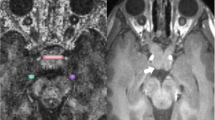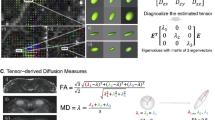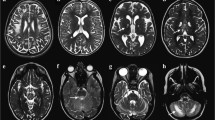Abstract
Background
Septo-optic dysplasia (SOD) refers to a heterogeneous group of midline brain developmental anomalies, with optic nerve hypoplasia (ONH) being one of the morphologic correlates of the condition. Traditionally, ONH has been diagnosed on fundoscopic exam. Conventional MRI is used in cases of suspected ONH to identify associated brain abnormalities and to compare findings to the fundoscopic exam. Advances in magnetic resonance diffusion tensor imaging (MRDTI) permit in vivo, noninvasive, quantitative characterization of the entire visual pathway at 3.0 T.
Objective
To investigate the feasibility of MRDTI at 3.0 T in children with SOD to evaluate the entire visual pathway.
Materials and methods
MRDTI at 3T was performed in two children with SOD and seven age-matched controls. Manual region-of-interest analysis was used to evaluate the tensor metrics of the optic nerves. Deterministic tractography was used to evaluate the tensor metrics of the optic radiations.
Results
The SOD patients demonstrated a significant decrease in anisotropy and increase in mean diffusivity of the optic nerves and radiations compared to the control subjects.
Conclusion
This study demonstrates the feasibility of MRDTI to evaluate the entire visual pathway in children, and it demonstrates pre- and post-chiasmatic diffusion tensor abnormalities in SOD patients.



Similar content being viewed by others
References
Kelberman D, Dattani MT (2007) Genetics of septo-optic dysplasia. Pituitary 10:393–407
Kelberman D, Dattani MT (2008) Septo-optic dysplasia—novel insights into the aetiology. Horm Res 69:257–265
Rollins NK (2007) Clinical applications of diffusion tensor imaging and tractography in children. Pediatr Radiol 37:769–780
Mori S, van Zijl PC (2002) Fiber tracking: principles and strategies—a technical review. NMR Biomed 15:468–480
Iwasawa T, Matoba H, Ogi A et al (1997) Diffusion-weighted imaging of the human optic nerve: a new approach to evaluate optic neuritis in multiple sclerosis. Magn Reson Med 38:484–491
Naismith RT, Xu J, Tutlam NT et al (2009) Disability in optic neuritis correlates with diffusion tensor-derived directional diffusivities. Neurology 72:589–594
Trip SA, Wheeler-Kingshott C, Jones SJ et al (2006) Optic nerve diffusion tensor imaging in optic neuritis. Neuroimage 30:498–505
Salmela MB, Cauley KA, Andrews T et al (2009) Magnetic resonance diffusion tensor imaging (MRDTI) of the optic nerves to guide treatment of pediatric suprasellar tumors. Pediatr Neurosurg (in press). doi:10.1159/000262442
Barker GJ (2001) Diffusion-weighted imaging of the spinal cord and optic nerve. J Neurol Sci 186(Suppl 1):S45–S49
Borchert M, Garcia-Filion P (2008) The syndrome of optic nerve hypoplasia. Curr Neurol Neurosci Rep 8:395–403
Birkebaek NH, Patel L, Wright NB et al (2004) Optic nerve size evaluated by magnetic resonance imaging in children with optic nerve hypoplasia, multiple pituitary hormone deficiency, isolated growth hormone deficiency, and idiopathic short stature. J Pediatr 145:536–541
Hellström A, Wiklund LM, Svensson E (1999) Diagnostic value of magnetic resonance imaging and planimetric measurement of optic disc size in confirming optic nerve hypoplasia. J AAPOS 3:104–108
Magoon EH, Robb RM (1981) Development of myelin in human optic nerve and tract. A light and electron microscopic study. Arch Ophthalmol 99:655–659
Schoth F, Krings T (2004) Diffusion-tensor imaging in septo-optic dysplasia. Neuroradiology 46:759–763
Jellison BJ, Field AS, Medow J et al (2004) Diffusion tensor imaging of cerebral white matter: a pictorial review of physics, fiber tract anatomy, and tumor imaging patterns. AJNR 25:356–369
Mukherjee P, Berman JI, Chung SW et al (2008) Diffusion tensor MR imaging and fiber tractography: theoretic underpinnings. AJNR 29:632–641
Author information
Authors and Affiliations
Corresponding author
Rights and permissions
About this article
Cite this article
Salmela, M.B., Cauley, K.A., Nickerson, J.P. et al. Magnetic resonance diffusion tensor imaging (MRDTI) and tractography in children with septo-optic dysplasia. Pediatr Radiol 40, 708–713 (2010). https://doi.org/10.1007/s00247-009-1478-0
Received:
Revised:
Accepted:
Published:
Issue Date:
DOI: https://doi.org/10.1007/s00247-009-1478-0




